Angora Rabbits 101: Feeding angora rabbits organically
Feeding angora rabbits organically takes some knowledge of bunny dietary needs as well as an understanding of the nutritional value of grains and greens. Read more on what we’ve learned here.
Dual Purpose Angora Rabbits:
Angora rabbits have two functions on a small homestead. First, they produce luxurious wool which can be spun into yarn and woven or knitted into soft, warm garments. Secondly, they produce offspring which can be sold as breeding rabbits to other people or used on the homestead for quality meat. (Note that rabbit meat is not kosher. )
Dietary Needs of Angora Rabbits:
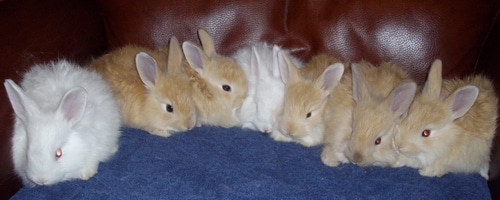
Their dietary needs reflect these two functions, and they, therefore, require a higher percentage of protein in their feed, than other rabbits.
Further, angora rabbits, with their long, thick wool coats are more susceptible to wool block than other rabbits, and therefore require a higher percentage of fibre and roughage in their diet. So any diet for angora rabbits needs to take into account their unique needs as both fibre producers and parents.
To complicate matters, angora rabbits that are at different stages of coat growth will have differing fibre needs. Further, pregnant and lactating females, as well as growing young have higher protein requirements than adult males and woollier females. Rabbits in winter have higher energy needs than rabbits in summer, and their diet should reflect these differing needs. Further, rabbits that have just been harvested and are growing a fresh wool coat, have a higher protein and caloric need than rabbits that have a full 4 inch coat and are warm and awaiting harvest. While rabbits in full coats have a higher fibre need than rabbits that have been freshly harvested.
Problems with Commercial Rabbit Pellets in the feeding of angora rabbits
Commercial feed is pretty much standard year-round. Since angora rabbits represent only a small market among the rabbit industry, there are no commercial feeds that are manufactured for their unique needs. Further, an analysis of rabbit feeds shows that their composition is almost entirely genetically modified (GM) ingredients. The standard 18% rabbit grower that we used to purchase for our rabbits contained soy, canola meal and oil, cottonseed meal and oil, and alfalfa, all four are genetically modified and grown through industrial agriculture that relies heavily on pesticides, herbicides, and monocropping. Further, feeds that rely heavily on GM soy, have been shown to reduce fertility, injure reproductive capacity in the second and third generation, and render livestock sterile. If you are currently feeding your rabbits commercial rabbit feeds and are finding a reduction in litter size or problems in conception or desire to breed, check out the ingredients in your feed, before you blame the rabbits.
Avoiding Genetically Modified Ingredients in Rabbit feed formulations
One way to avoid the GM ingredients in standard feeds is to use Certified Organic Feeds. Organic feeds are grown without chemical fertilizers, chemical herbicides, and chemical pesticides. However, they still rely heavily on soy, alfalfa, cottonseed meal, and canola meal, all common GM crops. While organic feed cannot knowingly include GM ingredients, because of cross pollination, and cross contamination, there may be GM ingredients in the feed. Recent random testing of the US alfalfa crop showed a 90 % contamination with the GM gene, even before GM alfalfa was approved to be sown in the United States in 2011. Our feed store told us, organic crops will not be tested for GM contamination, as the results, if contamination with GM organisms is found, could render the organic certification void, which would result in untold financial losses to the farm and the organic feed manufacturer.
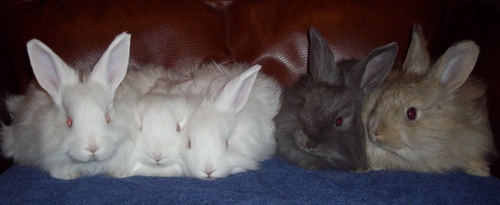
GM soy, canola, and cottonseed contain the Bt bacteria that attacks the digestive system of caterpillars and cause them to die. They also contain an antibiotic that is added to the gene and used as a marker to signal the presence of the GM gene. Once it is added to the gene of the plant, it is expressed in the DNA of all parts of the plant, including the pollen. Since it’s not an added ingredient, it does not have to be disclosed to the consumer. However, it is part of the complicated picture of antibiotic resistant bacteria that we are seeing in epidemic proportions, everywhere that large scale mono-cropping of GM crops and industrial agriculture is employed. I suggest that you want to avoid these ingredients, for the health of your rabbits and for your own health, both in handling the dusty feed and in producing household meat for your own family.
The GM organisms remain active in the gut of your rabbits, and in their meat, even after GM feeds are replaced by Organic feeds. They continue to reproduce as live organisms in the gut and can affect those who consume the meat, as well.
So how does a homesteader avoid GM feeds, especially in rabbits? I have not found, in Canada, any certified organic feeds formulated specifically for rabbits, nor any feeds at all that is specific to the unique needs of angora rabbits. The only feeds available from a commercial feed manufacturer are meat rabbit pellets — 18% grower or 15% adult feed. The 15% adult is not high enough in protein to provide for the extra needs of wool growth or pregnancy or lactation. The 18%, while providing for the extra protein needed for lactation, growth, and wool production lacks the fibre necessary to prevent wool block in angoras.
The Joybilee Farm experience
This can be overcome by feeding the 18% commercial rabbit pellets and adding free choice grass hay and free choice oat, wheat, or barley straw. They absolutely love oat straw and timothy hay, so if you are growing your own consider planting hull-less oats (15% protein) and timothy hay for them. And harvesting and drying it yourself, for their needs. On a small scale, these crops can be harvested with a scythe and allowed to dry like hay, for year-round feeding. Following this feeding regime, while you won’t avoid GM organisms in the feed, you will be offering your rabbits adequate protein and fibre for their unique needs. We went this route when we first started raising French Angora rabbits on our homestead. It worked for a while, but after a few generations, we began to notice reproductive issues in our rabbits, which included small litter sizes, disinterest in breeding in female rabbits, breast cancers in rabbits under a year old, and ovarian cancers in 2 years old rabbits. The year that pushed us to make the move to avoid GM feeds we saw 30% of our female rabbits exhibiting breast or ovarian cancers — all in rabbits that were 2 years old or younger.
We consulted our livestock vet, Dr. Ruth, and told her our concerns about the GM feeds, the decreased fertility we were seeing in our rabbits and our concerns over the increase in female cancers that we were experiencing in our rabbits. When we told her that we thought the cause was the GM ingredients in the rabbit pellets and that we were going to find another way, Dr. Ruth, was 100% supportive and told us that she was reading studies that implicated GM feed in fertility issues in livestock. “Definitely get them off the commercial feeds,” she said. Up till this time, we had removed the commercial feed from our chickens, goats, sheep, llamas, turkeys, and ducks. However, all these animals will thrive on feeds of 15 or 16% protein. We hesitated to remove the commercial pellets from our rabbits because we didn’t want a decrease in protein to adversely affect their health. But seeing cancers developing in young rabbits pushed us to make the change immediately.
We actually threw out the bags of conventional rabbit feed that we had, and switched all our rabbits to our own Joybilee Farm mix of whole grains, peas, flaxseed, and sunflower seeds, with fresh herbs, and weeds added to their diet in the summer, and grass/alfalfa hay and oat straw in winter.
Commercial feeds contain added vitamins and minerals to optimize your rabbit’s health. When you remove commercial pellets from your rabbits, especially if your rabbits are caged, you will need to find ways to replace the lost minerals in their diet. At first, we cut salt blocks, made for goats, in small squares and put them in our rabbits’ cages for them to chew on. These blocks, resting on the floor of the cages, were soiled with manure and became damp in the high humidity of the winter rabbit barn. They were ignored by the rabbits.
We added kelp meal to the feed mix and were able to increase their trace minerals this way. However, rabbits do not generally enjoy powdered feeds. Making mineral cookies for the rabbits may be a better way to increase their mineral supplementation.
We’ve now been feeding our own feed mix and fresh greens to our French Angora rabbits for two years. We’ve seen an increase in litter size, more interest in breeding, and rabbits that did have cancer had their tumours shrink in size, simply from changing their diet to a more natural diet, free of GM food. This is very encouraging.
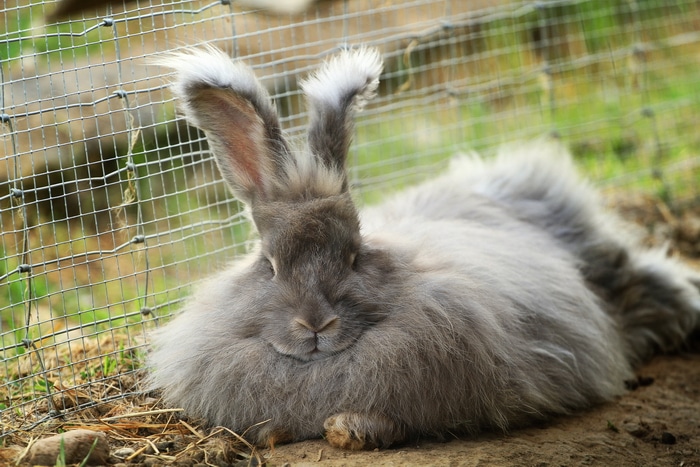
The Ideal Angora Rabbit Feed:
The ideal Angora feed based on studies done in Europe, where angora rabbits were raised commercially for their wool, is listed in Leslie Sampson and Sharon Kilfoyle’s book “Completely Angora” (1988).
Protein – 15 to 17%
Fiber – 14 to 16%
Fat – 2 to 4%
Salt – .5 to .7
Calcium – 1 to 1.2
Phospherus – .3 to .5
Copper (mg) 10
Iron (mg) 50
Zinc (mg) 40 to 50
Amino Acids:
Cystine & Methionine – .7%
Arginine – .6%
Lysine – .5%
Vitamin A (IU) 6,000 to 10,000
Vitamin D (IU) 500 to 1,500
Vitamin E (IU) 20 to 60
(Completely Angora, p. 37)
Using this rule we’ve formulated the following feed based on the ingredients that are available locally. Our feed source is Sure Crop feeds, plus local hay, oat straw, and the fresh food that we grow on our own land, organically.
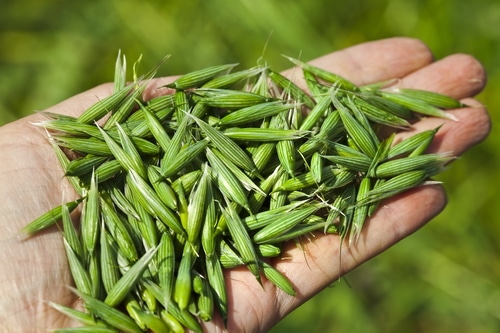
Joybilee Farm GMO-free Livestock Feed/Angora Rabbits Organic Feed
1 part whole oats
1 part whole wheat
1 part whole barley
1/2 part dried peas or split peas
1/4 part whole flax seed
1/4 part whole sunflower seed
Formulating your own GM-free Feed:
Never feed dried corn in your feed mix. It is too starchy for rabbits and encourages digestive upsets. If I could get hull-less oats, which have a protein profile of 15%, I would feed that with wheat and drop the barley, from the feed mix, while reducing the peas to 1/4 part of the mix. As more and more feed is being genetically modified, it is imperative that you keep informed and adjust the recipe as necessary to avoid the ingredients that are important to you to avoid. As alfalfa has now been added to the list of food that is genetically modified, Joybilee Farm will be avoiding alfalfa in all feed choices, except in cases where it has been tested to be GM free.
Each rabbit gets 1/2 cup of this feed each morning. Lactating does receive a double ration of 1 cup to 1 1/2 cups of this feed mix daily. Lactating does and their litters receive as much of this feed as the litter will eat, beginning at a week of age.
Fresh Food choices:
Rabbits can be offered up to 1 cup of fresh greens, fruit, or herbs each day, in addition to the dry feed. Fresh food helps ensure that your rabbit’s vitamins and mineral needs are met. If you haven’t been offering fresh feed, or after a winter when the fresh feed hasn’t been available, introduce fresh food slowly, gradually increasing the amount offered, over 4 weeks, until your rabbits can tolerate it without diarrhea. Young rabbits should be introduced to fresh feed very, very gradually.

In winter you can grow wheatgrass, radish sprouts, and dandelion greens for your rabbits indoors, by placing potted plants by the available windows. Rabbits that are bred in winter will do well with the extra fresh greens to add vitamins and minerals to their diet.
Economic Benefits of GM-free Feeds
I’ve presented in this post the reasoning behind our decision to avoid commercial rabbit pellets from a health perspective in our rabbitry. It is also more economical to grow your own feed, and to substitute whole grains, even from the feed supply outlets, rather than rely on commercial pellets. We save about 60% on our feed costs by buying bulk feed and feeding all our livestock from the same feed bag, simply adjusting the mineral needs of each species with added kelp meal, salt, and mineral blocks. Further, since switching from commercial pellets to whole grains we no longer see cases of wool block in our rabbitry.
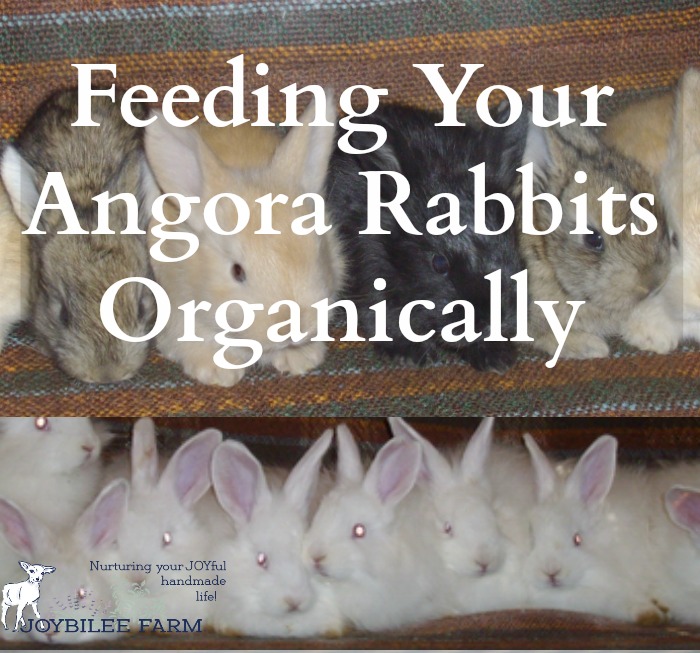
If you are new to raising angora rabbits, you can avoid many of the problems that I experienced, simply by starting them off on whole grains and avoiding GM ingredients right from the start. If you have been raising angora rabbits for many years, perhaps you have not experienced the same issues that I experienced here in Western Canada. If this is the case, consider yourself blessed. I am simply sharing my own experience and our move to more holistic and organic feeding regimes in our angoras. If you are experiencing some of the difficulties that we saw, consider changing your feeding regime and you may see some of these issues resolve themselves. In removing commercial pellets and substituting whole grains, you can remove the commercial pellets cold-turkey, while giving your rabbits free choice hay and straw. They will adjust to the new food gradually over a few weeks. However, once they have adjusted to whole grains, we’ve found that they will no longer eat commercial pellets, even when they are offered. That tells you something, doesn’t it?
Back to You:
What are your experiences in feeding angora rabbits? What works for you and what doesn’t? Leave a comment.
This is part of a series of posts on Angora Rabbits 101:
Part 1 -When Fluffy Bunny Becomes Matted
Part 2 -6 steps to dealing with Sore hocks in your Angora Rabbits
Part 3 – Feeding your Angora Rabbits organically (This post)
Part 4 – Breeding for colour: Understanding Colour Genetics: The self rabbit
Part 5 – Angora Bunny Colour Genetics: The wild rabbit colouring
Part 6 – Angora Bunny Colour Genetics: The Shaded Gene


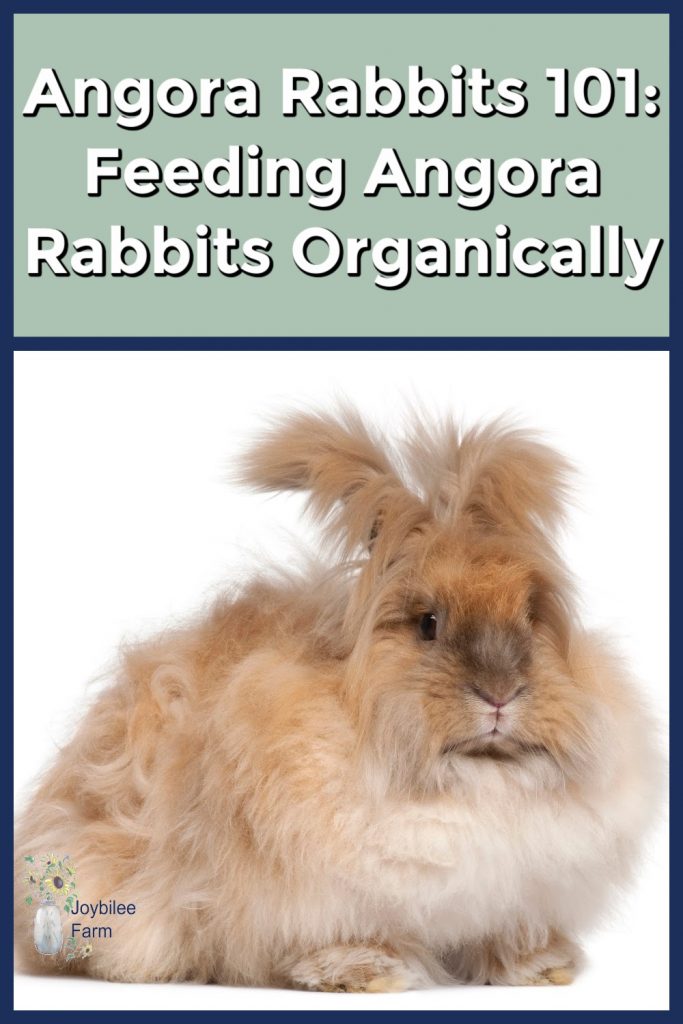

The best thing would be to talk to a livestock feed specialist to get individualized recommendations. Unless you want to do your own trials.
Thank you!! I have been searching for weeks for a more natural way of feeding my silver fox herd. Do you still use this feed? How do you know the protein, fiber, and fat percentage of your feed? If I feed this feed for my silver fox rabbits, for hay, would it be good to free feed my rabbits with alfalfa hay or orchard hay? Or a mixture of both? And for the minerals and vitamins, how much kelp meal per 50lb of the grain mixture would you add? Or if I gave them a hanging Himalayan salt cube would that be enough minerals and vitamins? Or what other mineral and vitamin rich ingredients should I add? And would regularly integrating fodder and occasional herbs and veggies make a balanced diet? So would hay, fodder (wheat or barley), the grain mixture, and occasional veggies and herbs make a balanced diet? I really wouldn’t want to miss a key mineral or something like that and injure my rabbits.